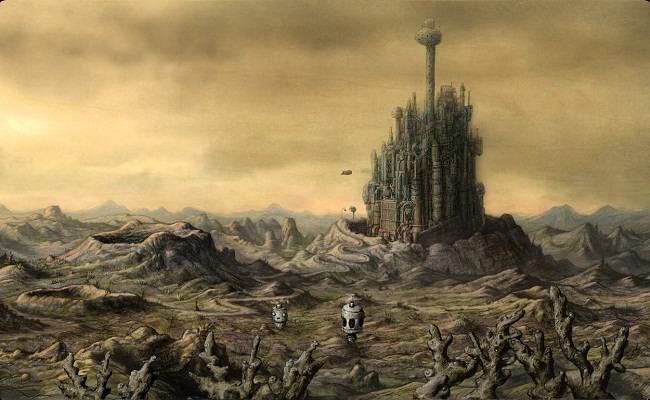Robots are cool! Some have death rays and machine guns for arms. Others have superhuman strength and rockets for feet. But a few are just harmless little machines with few special powers. Such is the hapless hero of the indie adventure game Machinarium.
A small robot named Josef is dumped in a trash heap at the beginning of the game, and players have to guide him back home through the many traps and hazards of his robot city. Players aren’t directly told how he came to be in this predicament, but the backstory is slowly revealed through flashbacks as Josef makes his way back home. There’s also a very charming system in which he’ll have longer flashbacks if the Player leaves him idle for a while. This rewards gamers stopping and thinking while playing.
And players will have to stop and think! Poor Josef doesn’t have many cool robo-powers. No built in jetpack or laser eyes, so puzzlesolving and finding non-violent solutions are his tools. All he can do is elongate his torso and arms to make himself a bit taller, or shorter. With this power he can grab objects high and low, and players have to figure out how to use the items they encounter to get Josef to get him past a series of puzzles, armed guards and other obstacles. It’s classic point ‘n; click adventure gaming at its best, and the many puzzles offer a brain-twisting challenge for puzzle fans too.
Machinarium eases players into its style of gameplay by making every room in the first quarter of the game a self-contained adventure. When Josef enters a space, he won’t be able to go on to the next location until the problem at hand is solved; items aren’t carried from area to area, or stockpiled for future use as with most adventure games (“Hey, I bet this inflatable duck with a hole in it will come in handy somewhere down the line”).
After a while, Josef will gain access to a wider section of the city and more elaborate quests will begin popping up. Players soon learn that he is trying to stop a villainous plot to destroy the city, and is searching for his lost robo-girlfriend too. Along the way, he’ll also help some other interesting characters like a trio of robot musicians, and robo-prisoners.
Despite it’s cutesy child-like story and aesthetics, Machinarium is a tough, smart game. The puzzles are logical and can be figured out with enough effort, but many of them are very difficult. The item-based adventure aspects offer a challenge too, especially for people aren’t used to puzzle gaming. Luckily, the designers built in two hint systems. One is a simple Light Bulb icon, and players can click this once per location to get an illustration of the basic goal for the area.
The other hint system is rather clever. Clicking an icon will bring up a window where the Player pilots a key through a sidescrolling shooter minigame. By blasting enemies, this key will eventually make its way to a keyhole at the end of the level. Once complete, this provides the player with step-by-step instructions on how to beat the current puzzle. This is very clever design because gamers who aren’t good at puzzles are likely to do well with the shooting mechanics of this minigame. It’s also rather slow and dull, so playing is something of a punishment for resorting to the hints.
The art is all hand-drawn and has a distinctly European cartoon look about it. No surprise given that its developed by Czech developer Amanita (Who also created Samorost). It’s gorgeous, and refreshing in this era of computer-generated art. There’s no dialog or text in the game; the robots communicate entirely through images show in thought bubbles. Even the hint system is based on images and thought bubbles.
There’s very little to complain about with Machinarium, but problems with the interface do arise. The pointer changes to a hand icon when the robot is next to an object he can interact with. But if the he is too far away, the pointer doesn’t change. This makes it hard to know exactly which items can be used to solve the puzzles. As with many adventure games, important items will get lost in the background, and this happens a few times here. Some of the more recent point ‘n’ click games use a “Hotspot” feature to highlight useable objects, but that is not the case with Machinarum and players are likely to spend a considerable amount of time hunting for missed items, like the elusive Plunger needed for one sequence.
There is a foot-shaped icon to show where the robot can walk, but certain locations can only be reached if the robot is standing right next to it. Again, this can make it hard to solve puzzles simply because the Player didn’t know that a particular object can be climbed, or that Josef can jump inside a particular spot.
However the handful of complaints I can make aren’t enough to prevent Machinarium from being an excellent game. It’s a fine example of both adventure gaming and puzzle gaming. Highly-recommended for fans of those genres. The sweet story, likeable protagonist, and interesting art make it something that should be played by gamers who aren’t necessarily adventure gamers too. It’s available now for PC, Mac, iOS, and has an upcoming PSN and Android editions.

0 Comments